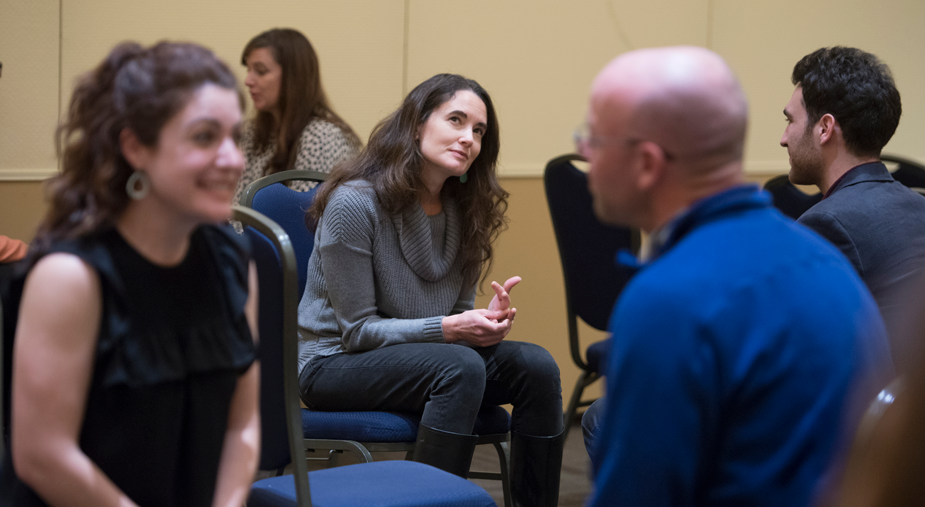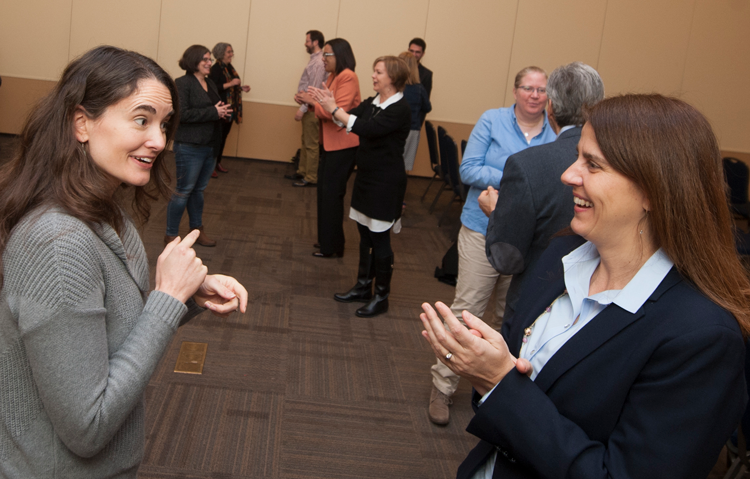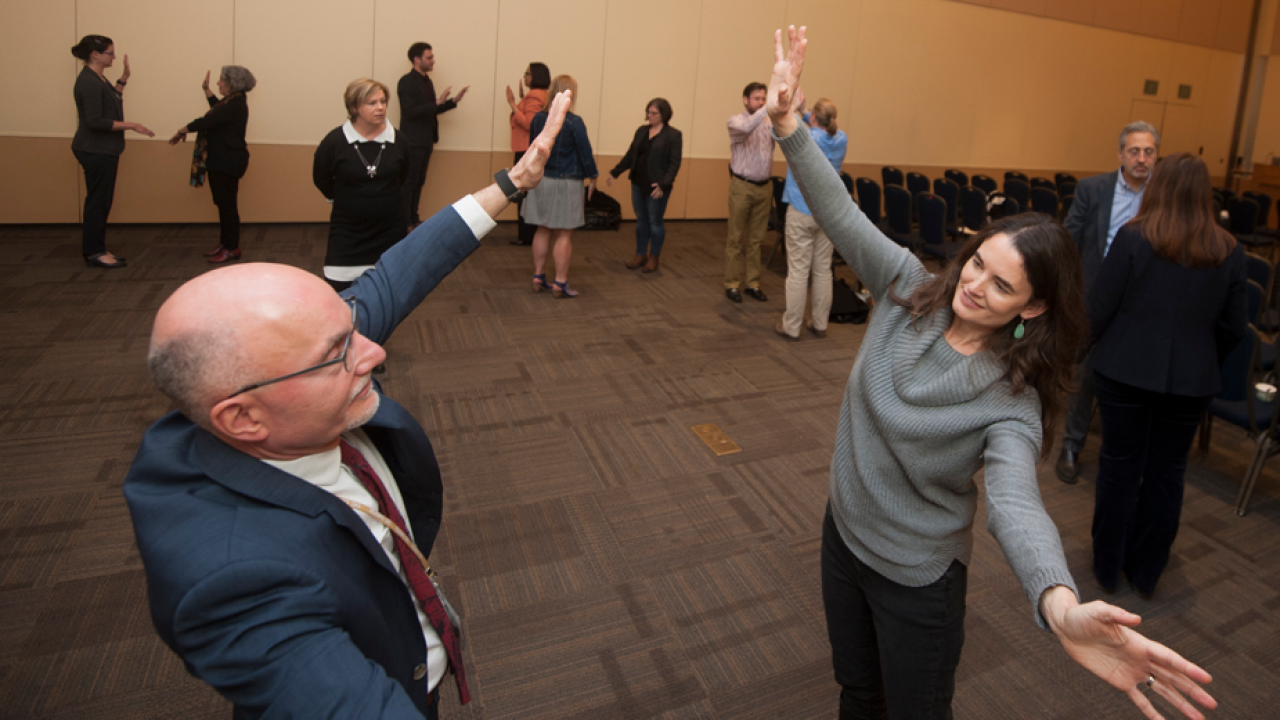“Hi, I’m Alan Alda. I’m a world-famous actor.”
He didn’t really need to introduce himself. Alda has starred in movies and television (perhaps most famously as Capt. Benjamin “Hawkeye” Pierce in M.A.S.H.), and hosted Scientific American Frontiers on PBS for 11 years. After interviewing hundreds of scientists, he wondered, what if we taught improvisation to scientists to help them connect to their audiences?
Alan Alda: ‘Scientific American’
That’s now the focus of the Alan Alda Center for Communicating Science, headquartered at Stony Brook University in New York.
For three days, Feb 1-3, I was one of 55 scientists, faculty, students and staff members taking part in the center’s training at UC Davis. Not everyone attending these workshops gets a personal welcome from the center’s namesake. But Alda was fresh from his public talk at the Mondavi Center for the Performing Arts the night before, and before we got started, he had some words of advice for us about improv.
“It’s so good to go through it as long as you’re not frightened to death by it,” he told us. “Lend yourself to it. You don’t have to be afraid.”
Improv, improve
When people think of improv, many think of comedy and acting.
But this wasn’t about either. Above all, it was about connecting with other people and being genuine. There was very little “talking at” us by the trainers. They mostly took us through experiences so we could feel for ourselves what it was like to connect, and then draw upon that when it came time for us to communicate.
They reminded us that most communication is nonverbal, so that’s where we began.
There was a powerful exercise where, in groups of two, we mirrored each other’s actions. We laughed as we created infomercials with two minutes of team planning. We teared up as we listened to people paint word pictures of their favorite photographs and describe what they mean to them. We got to rant for a minute while our partners turned our words into positive statements about what we value. For example: “This is Kat, and she values fairness.”

We also learned about the art of “Yes, and ....” It’s one of the first rules of improv: Rather than negate what the other person is saying, accept and use it to expand upon a thought. (“Yes, that is really upsetting. And that’s why ….”)
While “yes, but” is an incredibly tempting default for many of us, it’s not very effective in improv, or, it turns out, communication.
On the first day, these and other exercises set the stage. They provided us with an emotionally safe place to open up and become vulnerable, allowing us to internalize what connection felt like. Once the connection foundation was laid, we could better delve into what we wanted to say, as well as how to say it, through mock interviews and practice with our peers and trainers.
See and be seen
As a science writer and media relations specialist at UC Davis, I’ve attended and presented at several science communication workshops. I’ve interviewed hundreds of scientists and helped them prepare for media interviews. I’m generally the person behind the scenes. It’s a lot harder to do when you’re the one talking to the public.

In this training, I was not just an observer but a full participant. I had to think on my feet, be “on” all day, and “perform” in front of a room full of scientists and faculty. Some of them view me as a science communication expert. (Cue the imposter syndrome.) This pushed me out of my comfort zone, but in a good way.
It gave me a small glimpse of what our scientists experience all the time in reaching out to the public. They do their work and then they put themselves out there. They don’t always know their audiences or how those audiences will receive what is being presented. Sometimes those audiences are hostile; sometimes they’re adoring. Usually it’s somewhere in between. But the process of communication takes time and a willingness to listen and engage, to see and be seen.
Life skills
By the end of the second day, I was completely exhausted. Several of the other participants — doctors, neuroscientists, ecologists, engineers —said the same thing, remarking on early bedtimes the night before and a general sense that this was more intense than they had expected, yet also rewarding.
In the nearly two weeks since the workshop, I haven’t had to use the tools I learned in a media interview, but I’ve found myself dipping into them during work meetings, interactions with my friends, my kids, my mom. I’ve been trying — trying — to listen and connect, not just talk and explain.
The training has made me think about how to be a “yes, and” kind of person more often. These are not just skills for PowerPoint presentations, media interviews and policy briefings. These are skills we can learn throughout our lives, with our jobs, our families, our children, our friends.
In the spirit of communication and connection, I’ll share with you a few notes to self I wrote at the end of the training:
- Try to drain out the noise and chatter in your head and focus.
- Know you’ve got this.
- Take time to think through your main points.
- Know you deserve to be here.
- Trust your instincts.
- Know this of the mistakes and the hard, hostile audiences — you can learn from them, too. You can learn about who you are.
Science communication resources at UC Davis
The Office of Strategic Communications offers monthly communications training to faculty. Contact: Mary Nauer, manauer@ucdavis.edu.
SPEAK (Scientists for Public Engagement and Knowledge), through the Center for Watershed Sciences, offers a variety of science communication seminars throughout the year. Contact: Megan Nguyen, meknguyen@ucdavis.edu.
Science SAYS is a team of graduate students offering science communication training to UC Davis students.
Media Resources
Kat Kerlin, UC Davis News and Media Relations, 530-750-9195, kekerlin@ucdavis.edu
